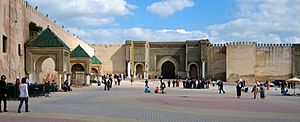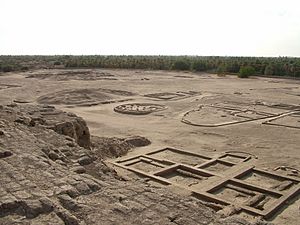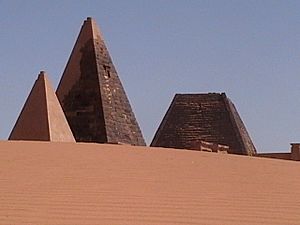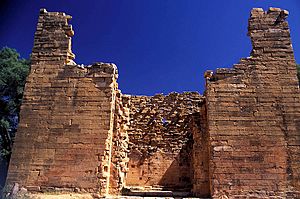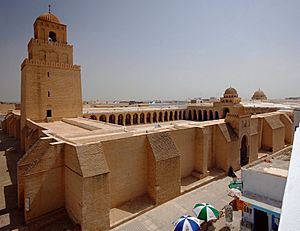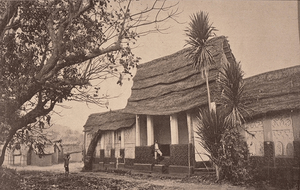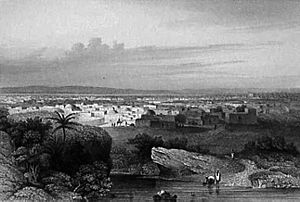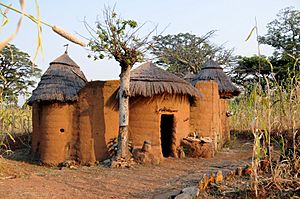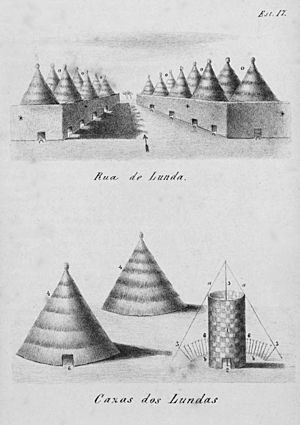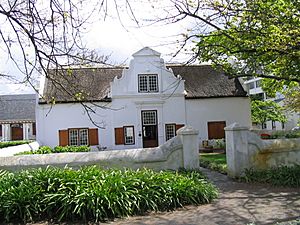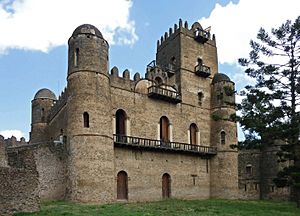Architecture of Africa facts for kids
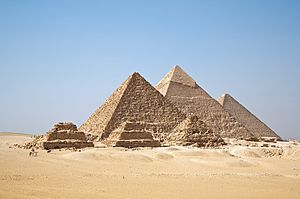
African architecture is super diverse, just like the many cultures across Africa. For thousands of years, Africans have created their own special ways of building. Sometimes, you can even see similar building styles across large areas, like the Sudano-Sahelian architecture in West Africa. A cool idea in traditional African building is called fractal scaling. This means that small parts of a building or village often look like the bigger parts. Imagine a village made of round houses, where the whole village itself is also round!
People from other cultures have influenced African architecture for a very long time. Since the late 1400s, European building styles have become popular in coastal areas. Today, these styles inspire many big buildings, especially in large cities.
African builders use many different materials. These include thatch (like straw roofs), wood, mud, mudbrick, packed earth, and stone. The materials used often depend on the region. For example, North Africa uses more stone and packed earth. The Horn of Africa uses stone and mortar. West Africa uses mud or adobe, while Central Africa uses more thatch and wood. In Southeast and Southern Africa, stone and thatch/wood are common.
Contents
- Ancient African Buildings
- Medieval Architecture
- Modern Architecture
- Images for kids
- See also
Ancient African Buildings
The most famous buildings in Africa are probably the Pyramids of Egypt. They are still seen as one of the world's greatest early building achievements. These huge structures were mostly built as tombs for pharaohs. Egyptians also built massive temple complexes.
We don't know as much about ancient buildings south and west of the Sahara Desert. There are mysterious stone pillars around the Cross River with cool designs. The many Senegambian stone circles also show that early architecture was developing.
North Africa's Early Buildings
Egypt's Ancient Structures
Ancient Egypt was famous for its temples, walled cities, canals, and dams. Their building skills were truly advanced for their time.
Maghreban Architecture
The Berbers of northwest Africa built thousands of tombs before Christianity arrived. One of the most famous is the Tomb of the Christian Woman in western Algeria. This tomb has columns, a dome, and spiral paths leading to a single room inside.
Morocco's Unique Style
Morocco's buildings show its varied landscape and long history. The country has seen many different groups of people and armies over time.
Moroccan architecture began around 110 BCE with the Berbers' huge mudbrick buildings. Later, Islamic architecture influenced the designs, especially under the Idrisid dynasty. Moorish architecture was brought by people from Spain, and French designs arrived during the time of the French protectorate in Morocco.
Nubia's Ancient Wonders
Nubian architecture is one of the oldest in the world. The earliest style, from the A-Group culture (3700-3250 BCE), included structures carved right out of solid rock, called speos. The Egyptians later used this idea for places like Abu Simbel. The C-Group culture, which followed, first built with light materials like animal skins and wattle and daub. Later, larger buildings made of mudbrick became common.
The C-Group culture was linked to the city of Kerma, built around 2400 BC. Kerma was a walled city with religious buildings, large round homes, a palace, and well-planned roads. It had about 2,000 people living there. One of its most lasting buildings was the Deffufa, a mudbrick temple where ceremonies took place.
Between 1500 and 1085 BC, Egypt took over Nubia. This led to the Napatan period and the start of the Kingdom of Kush. Kush was greatly influenced by Egypt and even conquered Egypt later on. During this time, many pyramids and temples were built. Gebel Barkal in Napata was an important place where Kushite kings were crowned.
Thirteen temples and two palaces have been found in Napata, but more is still hidden. Sudan has 223 Nubian pyramids, which are smaller but more numerous than the Egyptian pyramids. They are found at three main sites: El Kurru, Nuri, and Meroe. Nubian pyramids were built for kings and queens. They had steep walls, a chapel facing east, and a chamber reached by a stairway. The Meroe site has the most pyramids and is considered the largest archaeological site in the world. Around AD 350, the Kingdom of Aksum invaded, and the Napatan kingdom ended.
Horn of Africa's Early Buildings
Aksumite Architecture
Aksumite architecture was very important in Ethiopia. You can still see its influence in the medieval churches of Lalibela. Here, tall stone pillars (called hawilts) and even whole churches were carved out of single blocks of rock. Other big structures include huge underground tombs, often found under these stone pillars. Famous examples of these carved-from-rock buildings include the Tomb of the False Door and the tombs of Kaleb and Gebre Mesqel in Axum.
Most buildings, like palaces, homes, and other churches, were built with alternating layers of stone and wood. Some had white-painted outsides or insides, like the 12th-century monastery of Yemrehanna Krestos. Old Aksumite houses were one-room stone buildings, two-story square houses, or roundhouses made of sandstone with basalt foundations. Villas were usually two to four stories tall with large rectangular layouts. A great example of Aksumite architecture that still stands is the Debre Damo monastery from the 6th century.
West Africa's Early Buildings
Tichitt Walata Settlements
Tichitt Walata is the oldest group of settlements still standing in West Africa. It's also the oldest stone-based settlement south of the Sahara Desert. The Soninke people built it, and it's thought to be a very early version of the Ghana Empire. People who farmed and raised animals lived here around 2000–300 BCE. This makes it almost 1000 years older than people first thought! These settlements had well-planned streets and strong, walled areas, all made with skilled stone work. There were about 500 settlements in total.
Nok Culture
Artifacts from the Nok culture in Nigeria date back to 790 BCE. They show that people often built their homes on hilltops and mountain peaks. However, not many Nok settlements have been fully dug up by archaeologists.
The Sao civilization built walled cities in the Lake Chad region. The oldest site, at Zilum, Chad, dates back to at least the first millennium.
Gobarau Mosque
The Gobarau Mosque was likely finished during the rule of Muhammadu Korau (1398–1408), the first Muslim king of Katsina. It was first built as the main mosque for Katsina town and later became a school. By the early 1500s, Katsina was a very important trading and learning center in Hausaland. The Gobarau Mosque became a famous Islamic university. It remained Katsina's main mosque until the early 1800s.
Other Ancient Nigerian Societies
Many societies in ancient Nigeria built structures from earth and stone. These buildings were often for defense, to protect against other tribes. But many settlements also added spiritual meanings to their construction. These defensive walls were mostly made of earth, sometimes covered with plaster.
Some walls were made of an outer ditch and an inner bank. These could be from half a meter to 20 meters wide in big settlements like Benin and Sungbo's Eredo. In the Guinea and Sudan savannas, walls were built in layers of mud. Each mud layer was held in place by wood, allowed to dry, and then another layer was added. At Koso, these walls were about 6 meters high, getting thinner from 2 meters thick at the bottom to half a meter thick at the top. In northern Nigeria, Tubali walls used sun-dried mud bricks held together with mud mortar. These walls can wear down in wet climates.
These mud buildings were usually covered with plaster made of mud mixed with other things. This made the surface smoother and harder to climb, helping to keep attackers out. Some plaster has even been found with blood, bone, gold dust, oil, and straw mixed in. Some of these materials made the walls stronger, while others had spiritual meanings, perhaps to protect against evil spirits.
Benin City had very clever house and city planning. Houses had several rooms and usually roofs. They included private areas, sacred spaces, and rooms for guests. Often, several houses would share a courtyard. When it rained, the house roofs would collect water into a spot in the courtyard for later use. Houses faced long, straight roads. The city had markets and the chief's palace in the center, with main and smaller roads leading out. An early explorer described the roads as "fenced with tall [water cane] neatly set very close together in uniform rows..." possibly for privacy.

More advanced building methods included stone and brick structures, sometimes with mortar and plaster, and often with defensive features. Fired brick buildings were found in northeast Nigeria, like old Kanuri buildings. Many of these bricks have since been used for new constructions. Walls made of laterite blocks with clay mortar were found in northwest Nigeria, possibly inspired by Songhai buildings. Walls built from stone without mortar were found where enough stone was available, especially in Sukur. These stone walls were not usually plastered.
The Sukur World Heritage Site is very important. It has many terraces, walls, and other structures. Walls separate homes, animal pens, and grain storage. Terraces often include spiritual items like sacred trees or ceramic shrines. Early iron workshops were also present, usually near the owners' homes.
There are three main styles of homes in traditional Nigerian architecture, linked to the different groups of people who built them:
- Hausa architecture uses plastered adobe to create solid walls. Roofs are shallow domes and vaults made from wooden beams covered with earth. Homes are surrounded by outer walls, with circular and straight inner divisions and one clear entrance.
- Yoruba architecture uses dried earth walls to support roof timbers, which are then covered with leaf or woven grass roofs. These walls are usually solid mud, though some places use wattle and daub. Spaces are divided into separate units connected by closeness and walls, forming a compound with courtyards and private areas. Multiple entrances allow access to other facilities like kitchens.
- Igbo architecture uses similar building methods and materials as Yoruba architecture, but the way spaces are arranged is very different. There are no single compound walls. Instead, individual units are linked to a central leader's hut, with importance given to their position and size.
These old building ideas still influence how homes are designed today, especially in how public, semi-public, semi-private, or private spaces are planned.
Medieval Architecture
North Africa's Medieval Buildings
When Islam spread to North Africa, Islamic architecture developed in the region. Famous buildings like the Great Mosque of Kairouan and the Cairo Citadel were built.
Around 1000 AD, a building material called cob (or tabya) first appeared in North Africa and parts of Spain.
Horn of Africa's Medieval Buildings
Somali Architecture
Somali architecture has a rich history of designing and building many types of structures. These include stone buildings, castles, fortresses, mosques, temples, aqueducts (water channels), lighthouses, towers, and tombs. This happened during ancient, medieval, and early modern times in Somalia. Today, Somali architecture also mixes traditional Islamic styles with Western designs.
In ancient Somalia, pyramid-shaped structures called taalo were a common way to bury people. Hundreds of these dry stone monuments are still found across the country today. Houses were built of cut stone, similar to those in Ancient Egypt. There are also examples of courtyards and large stone walls, like the Wargaade Wall, which enclosed settlements.
When Islam peacefully arrived in Somalia during the early medieval period, it brought Islamic building ideas from Arabia and Persia. This led to a change in building materials. Instead of dry stone, people started using coral stone, sun-dried bricks, and a lot of limestone. Many new buildings, like mosques, were built on top of older structures. This practice continued for centuries.
Aksumite Influence Continues
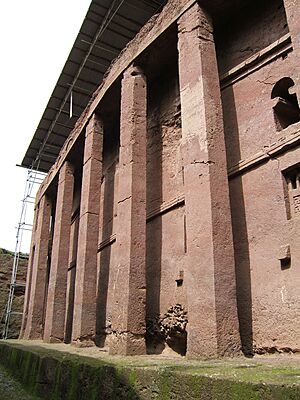
During the medieval period, the unique style of carving buildings from single rocks, seen in Aksumite architecture, continued. Its influence was strongest in the early medieval (Late Aksumite) and Zagwe periods. This was when the famous churches of Lalibela were carved. Throughout the medieval period, especially from the 10th to 12th centuries, churches were carved out of rock all over Ethiopia. This was very common in the northern region of Tigray, which was the heart of the Aksumite Empire. However, rock-carved churches have been found as far south as Adadi Maryam (15th century), about 100 kilometers south of Addis Abeba.
The most famous examples of Ethiopian rock-carved architecture are the 11 churches of Lalibela. They were carved out of the red volcanic rock found around the town. While old stories say King Lalibela built all 11, new evidence suggests they might have been built over a few centuries. Only some of the more recent churches might have been built during his rule. One expert, David Phillipson, thinks that Bete Gebriel-Rufa'el was actually built much earlier, between 600 and 800 AD, first as a fortress and later changed into a church.
West Africa's Medieval Buildings
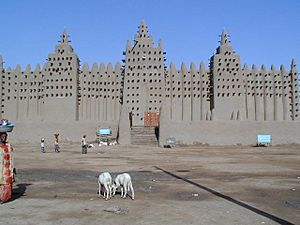
Ghana's Medieval Cities
In Kumbi Saleh, people lived in dome-shaped homes in the king's part of the city, surrounded by a large wall. Traders lived in stone houses in another area that had 12 beautiful mosques. One of these was for Friday prayers. The king was said to have several mansions. One was 66 feet long and 42 feet wide, with seven rooms, two stories, a staircase, and paintings on the walls.
Sahelian architecture first grew in the cities of Djenné and Timbuktu. The Sankore Mosque, made of mud and timber, looked similar to the Great Mosque of Djenné.
Ashanti architecture from Ghana is well-known from the reconstructed buildings in Kumasi. Key features include buildings built around courtyards and walls with striking designs made from brightly painted mud plaster. You can see an example of a shrine at Bawjiase in Ghana. It has four rectangular rooms, built from wattle and daub, arranged around a courtyard. Animal designs decorate the walls, and palm leaves cut into layers form the roof.
Yoruba Fortifications
The Yoruba surrounded their settlements with huge mud walls. Their buildings had a similar layout to the Ashanti shrines, but with verandahs around the courtyard. The walls were made of puddled mud and palm oil. The most famous Yoruba fortification, and the second largest wall structure in Africa, is Sungbo's Eredo. This huge structure was built in honor of a traditional leader named Bilikisu Sungbo in the 9th, 10th, and 11th centuries. It consists of sprawling mud walls among the valleys around the town of Ijebu-Ode in Ogun State. Sungbo's Eredo is the largest pre-colonial monument in Africa, even bigger than the Great Pyramids or Great Zimbabwe.
Kanem-Bornu Empire
The capital city of the Kanem-Bornu Empire, Birni N'Gazargamu, may have had 200,000 people. It had four mosques that could hold up to 12,000 worshippers. The city was surrounded by a 25-foot-high wall, more than 1 mile around. Many large streets led from the main square and connected to 660 other roads. The main buildings were made of red brick. Other buildings were made of straw and adobe.
Hausa Kingdoms
The important Hausa Kingdoms city of Kano was surrounded by strong walls of stone and bricks. Kano had a citadel near where the royal court lived. Individual homes were separated by earth walls. The higher the person's status, the more detailed their wall. The entrance was like a maze to keep women private. Inside, near the entrance, were the homes of unmarried women, and further in were slave quarters.
Benin City
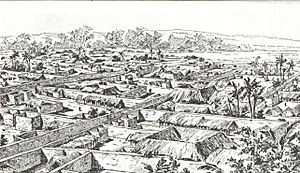
The rise of kingdoms in West Africa's coastal region led to architecture that used local traditions, especially wood. Benin City, which was destroyed in 1897, was a large complex of homes made of layered mud, with sloped roofs of shingles or palm leaves. The palace had many ceremonial rooms and was decorated with brass plaques. The Walls of Benin City were the largest man-made structure in the world. Fred Pearce wrote in New Scientist:
They extend for some 16,000 kilometers in all, in a mosaic of more than 500 interconnected settlement boundaries. They cover 6500 square kilometers and were all dug by the Edo people. In all, they are four times longer than the Great Wall of China, and consumed a hundred times more material than the Great Pyramid of Cheops. They took an estimated 150 million hours of digging to construct, and are perhaps the largest single archaeological phenomenon on the planet.
Central Africa's Medieval Buildings
Kongo Kingdom
With over 30,000 people, Mbanza Congo was the capital of the Kingdom of Kongo. The city was on top of a cliff, with a river below in a forested valley. The king's home was described as a large area, 1.5 miles long, with walled paths, courtyards, gardens, decorated huts, and fences. An early explorer said it looked like a Cretan labyrinth.
Kuba Kingdom
The capital of the Kuba Kingdom was surrounded by a 40-inch-high fence. Inside were roads, a walled royal palace, and city buildings. The palace was rectangular and in the center of the city.
Luba Empire
The Luba people often lived in small villages, with rectangular houses facing a single street. Local village governments were led by Kilolo, who were under the king's protection. Cultural life was centered around the kitenta, the royal compound, which later became a permanent capital. The kitenta attracted artists, poets, musicians, and craftspeople, supported by the king and his court.
Lunda Kingdom
Musumba, the capital of the Kingdom of Lunda, was 100 kilometers from the Kasai River, in open woodland between two rivers 15 kilometers apart. The city was surrounded by strong earthen walls and dry moats. The home of the Mwato Yamvo (the ruler) was surrounded by large, double-layered tree or wood fences. Musumba had many courtyards for different uses, straight roads, and public squares. European visitors noted how clean it was.
Eastern Lunda
The home of the Kazembe in Eastern Lunda was described as having fenced roads a mile long. The enclosing walls were made of grass, 12 to 13 spans high. The enclosed roads led to a rectangular hut open on the west side. In the center was a wooden base with a statue about 3 spans high.
Maravi People
The Maravi people built bridges (uraro) out of bamboo because river depths changed often. Bamboo pieces were placed side-by-side and tied together with bark (maruze). One end of the bridge would be tied to a tree. The bridge would curve downwards.
East Africa's Medieval Buildings
Tanzania's Ancient Settlements
Engaruka is a ruined settlement on the slopes of Mount Ngorongoro in northern Tanzania. It had seven stone-terraced villages. A complex system of stone channels along the mountain's base was used to control and direct river waters for irrigation of individual plots of land. Some of these irrigation channels were several kilometers long. The channels watered a total area of 5,000 acres.
Burundi's Royal Hills
Burundi never had a fixed capital city. The closest thing was a royal hill. When the king moved, his new location became the insago. The royal compound itself was enclosed by a high fence and had two entrances. One was for herders and their animals. The other led to the royal palace, which was also surrounded by a fence. The royal palace had three royal courtyards, each with a special purpose: one for herders, one as a sacred place, and one with a kitchen and grain storage.
Rwanda's Royal Capital
Nyanza was the royal capital of Rwanda. The king's home, the Ibwami, was built on a hill. Surrounding hills had permanent or temporary homes. These were round huts surrounded by big yards and tall hedges to separate the compounds. The Rugo, the royal compound, was circled by reed fences enclosing thatched houses. The houses for the king's helpers had mats on the floor and clay fireplaces in the center. For the king and his wife, the royal house was nearly 200-100 yards long and looked like a huge maze of connected huts and grain storage buildings. It had one entrance that led to a large public square called the karubanda.
Kitara and Bunyoro Earthworks
In western Uganda, there are many earthworks near the Katonga River. These are thought to belong to the Empire of Kitara. The most famous, Bigo Bya Mugenyi, is about 4 square miles. Its ditch was dug by cutting through 200,000 cubic meters of solid rock and earth. The earthwork wall was about 12 feet high. It's not certain if it was for defense or for keeping animals. Not much is known about these Ugandan earthworks.
Buganda's Moving Capitals
At first, the hilltop capital, or kibuga, of Buganda would move to a new hill with each new ruler, or Kabaka. In the late 19th century, a permanent kibuga was set up at Mengo Hill. The capital, 1.5 miles across, was divided into sections for different provinces. Each chief built homes for his wife, servants, and visitors. Large areas were available for planting bananas and fruits. Roads were wide and well-maintained.
Christian and Islamic Nubia
Christianity came to Nubia in the 6th century. Its most common buildings were churches. Their design was based on Byzantine churches, but they were smaller and made of mud bricks. Not many everyday buildings from the Christian period have been found. Soba is the only city that has been dug up. Its buildings are made of sun-dried bricks, just like today, except for one arch. During the Fatimid time of Islam, Nubia became more Arabized. Its most important mosque was the Mosque of Derr.
Swahili States
Further south, more trade with Arab merchants and the growth of ports led to the birth of Swahili architecture. This style grew out of local Bantu settlements. One of the earliest examples is the Palace of Husuni Kubwa, west of Kilwa, built around 1245. Like many early Swahili buildings, coral rag (pieces of coral) was the main building material. Even the roof was made by attaching coral to timbers. The palace at Kilwa Kisiwani was a two-story tower inside a walled area. Other important buildings from this time include the pillar tombs of Malindi and Mnarani in Kenya and other places. They were first made of coral rag, and later of stone. More recent examples include Zanzibar's Stone Town, with its famous carved doors, and the Great Mosque of Kilwa.
Southern Africa's Medieval Buildings
Afrikaner Architecture
Cape Dutch architecture is a traditional building style of the Afrikaners. It's one of the most unique types of settler architecture in the world. It developed over 150 years when the Cape was a Dutch colony. Even by the early 1800s, fewer than 50,000 people lived in the colony, spread over an area about the size of the United Kingdom. Cape Dutch buildings looked very consistent and were clearly related to rural architecture in northwestern Europe. But they also had their own clear African character and features.
Shona Architecture
Mapungubwe is considered the most complex society in southern Africa and the first to show economic differences. The wealthy people lived separately in a mountain settlement made of sandstone. It was an early version of Great Zimbabwe. Large amounts of dirt were carried to the top of the hill. At the bottom of the hill was a natural amphitheater, and at the top was a graveyard for the elite. There were only two paths to the top, one following a narrow, steep crack along the side of the hill, which people at the top could easily see.
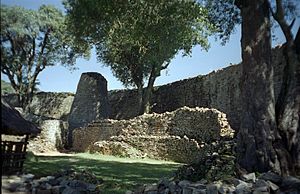
Great Zimbabwe was the largest medieval city in sub-Saharan Africa. It was built and expanded for over 300 years in a local style that used flowing curves instead of straight lines. It was not the first or last of about 300 similar sites on the Zimbabwean plateau, but Great Zimbabwe stands out because of its huge structures. Its most impressive building, called the Great Enclosure, has stone walls as high as 36 feet, stretching for about 820 feet. This makes it the largest ancient structure south of the Sahara Desert. Houses inside the enclosure were circular and built of wattle and daub, with conical thatched roofs.
Khami was the capital of the Torwa State. It followed Great Zimbabwe, and the building techniques learned there were made even better and more complex. Fancy walls were built by connecting carefully cut stones to form terraced hills.
Sotho-Tswana Architecture
Sotho–Tswana architecture is another stone-building tradition in southern Africa. It was centered in the Transvaal, a high grassland area north and south of the Vaal River. Many large stone-walled enclosures and stone house foundations have been found there. Tswana, the capital of the Kwena (ruler), was a stone-walled town as large as the capital of Eastern Lunda.
Zulu and Nguni Architecture
Zulu Architecture used materials that didn't last as long. Dome-shaped huts are often what people think of when they imagine Zulu homes. But later, their design changed to domes over cylinder-shaped walls. Zulu capital cities were oval-shaped. The outside was lined with a strong wooden fence. Dome-shaped huts, in rows of 6 to 8, stood just inside this fence. In the center was the kraal, an empty circular area used by the king to inspect his soldiers, keep cattle, or hold ceremonies. It was enclosed by a less strong inner fence compared to the outer one. The city entrance was opposite the fortified royal area called the Isigodlo.
Madagascar's Unique Homes
The first settlers of Madagascar came from Southeast Asia, and this is seen in the island's architecture. Homes are typically rectangular with pointed roofs and often built on short stilts. Houses along the coast, usually made of plant materials, look more like those in East Africa. Homes in the central highlands tend to be built of cob or brick. When European missionaries introduced brick-making in the 19th century, a special Malagasy architectural style appeared. It mixed traditional wooden noble homes with European details.
Namibia's Fortress
The fortress of ǁKhauxaǃnas, built by the Oorlam people in southeastern Namibia, included a wall 700 meters long and 2 meters high. It was built with stone slabs and shows features of both the Zimbabwean and Transvaal-Free-State styles of stone construction.
Modern Architecture
Ethiopia's Many Influences
In the early modern period, Ethiopia started to take in many new building ideas. These included Baroque, Arab, Turkish, and Indian styles. This began with the arrival of Portuguese Jesuit missionaries in the 16th and 17th centuries. Portuguese soldiers had first come in the mid-16th century to help Ethiopia fight against Adal. The Jesuits came hoping to convert the country to Catholicism.
Some Turkish influence might have entered Ethiopia in the late 16th century during Ethiopia's war with the Ottoman Empire. This led to more fortresses and castles being built. Ethiopia, with its many flat-topped mountains (ambas) and rough land, didn't get much tactical use from these structures. They were more useful on flat land in Europe. So, Ethiopia hadn't really built many castles before. Castle building, especially around the Lake Tana region, began with the rule of Sarsa Dengel. Later emperors continued this tradition, eventually leading to the creation of the Fasil Ghebbi (royal group of castles) in the new capital, Gondar (1635).
Emperor Susenyos (ruled 1606-1632) converted to Catholicism in 1622 and tried to make it the official religion from 1624 until he stepped down. During this time, he hired Arab, Indian (brought by the Jesuits), Jesuit, and local builders, some of whom were Beta Israel. He adopted their styles. When his son Fasilides became emperor, most of these foreigners were sent away. However, some of their building styles were kept and became part of the Ethiopian architectural style. This style of the Gondarine dynasty lasted throughout the 17th and 18th centuries and influenced modern styles in the 19th century and later.
West African Colonial Forts
Early European colonies on the West African coast built large forts. You can see examples at Elmina Castle, Cape Coast Castle, Christiansborg, Fort Jesus, and other places. These forts were usually plain, with little decoration. But Dixcove Fort had more fancy details. More decorations were added over time, and this style inspired later buildings like Lamu Fort and the stone palace of Kumasi.
European Styles in Africa
By the late 19th century, most buildings in Africa copied popular European styles. They mixed designs from the Mediterranean or even Northern Europe. Examples of colonial towns from this time still exist in Saint-Louis, Grand-Bassam, Swakopmund, Cape Town, and Luanda. Some buildings were even built in Europe, then shipped over and put together. This European tradition continued well into the 20th century, with the building of European-style manor houses, like Shiwa Ng'andu in Zambia, or the Boer farmhouses in South Africa, and many town buildings.
Bringing Back Traditional Styles
Interest in traditional African building styles started to come back in Cairo in the early 19th century. This idea spread to Algiers and Morocco by the early 20th century. From then on, colonial buildings across Africa began to use parts of traditional African architecture. The Jamia Mosque in Nairobi is a good example. In some cases, architects tried to mix local and European styles, like at Bagamoyo.
Modernism in Architecture
The impact of modern architecture began to be felt in the 1920s and 1930s. Famous architect Le Corbusier designed several plans for Algeria that were never built, including ones for Nemours and for rebuilding Algiers. Elsewhere, Steffen Ahrends worked in South Africa, and Ernst May worked in Nairobi and Mombasa.
Italian futurist architecture greatly influenced the designs of Asmara. Planned villages were built in Libya and Italian East Africa, including the new town of Tripoli, all using modern designs.
After 1945, Maxwell Fry and Jane Drew, who designed British schools, also worked in Ghana and designed the University of Ibadan. Rebuilding Algiers offered more opportunities, with the Sacred Heart Cathedral of Algiers and universities designed by famous architects like Oscar Niemeyer and Kenzo Tange. But modern architecture mostly remained the work of European architects until the 1960s. One exception was the Transvaal Group in South Africa, which built homes inspired by Walter Gropius and Le Corbusier.
Post-Colonial Architecture
After colonialism ended, many new cities were built, and others grew much larger. Perhaps the best example is Abidjan, where most buildings were still designed by famous non-African architects. In Yamoussoukro, the Basilica of Our Lady of Peace of Yamoussoukro shows a desire for huge, impressive buildings in these new cities. Arch 22 in the old Gambian capital of Banjul shows a similar bold style.
New and experimental designs have also appeared. A notable example is the Eastgate Centre in Zimbabwe. This building has an advanced natural air-conditioning system. It was designed to perfectly suit Harare's climate and needs, instead of just copying less suitable designs from elsewhere. The use of new vernacular architecture (local, traditional styles) continues, for example, with the Great Mosque of Nioro or New Gourna.
Other important structures built in recent years include some of the world's largest dams. The Aswan High Dam and Akosombo Dam hold back the world's largest reservoirs. In recent years, many nations have also started building new bridges. The Trans-Gabon Railway is perhaps the last of the great railways to be built.
Images for kids
-
Sideway view of a Dervish fort/Dhulbahante garesa in Eyl, Somalia
-
Tomb of Askia in Gao, Mali
-
Architecture in Antananarivo, Madagascar, in 1905
-
Downtown Lusaka, capital city of Zambia with FINDECO House on the right
-
Courtyard of the Al-Azhar Mosque in Cairo, founded in 972
-
Exterior of the Funerary complex of Sultan Qalawun (1285), which included a mausoleum, a madrasa, and a maristan
-
University of al-Qarawiyyin in Fes (founded in 9th century)
-
Almoravid Qubba in Marrakesh (early 12th century)
-
Arabesque, Maghrebi script, and zillīj at Al-Attarine Madrasa in Fes (14th century)
-
El Badi Palace in Marrakesh (late 16th century)
See also
 In Spanish: Arquitectura africana para niños
In Spanish: Arquitectura africana para niños


